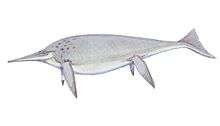Xinminosaurus
Xinminosaurus is an extinct genus of cymbospondylid ichthyosaur known from the Middle Triassic (mid-late Anisian stage) of Guizhou Province, China.
| Xinminosaurus | |
|---|---|
| Scientific classification | |
| Kingdom: | Animalia |
| Phylum: | Chordata |
| Class: | Reptilia |
| Order: | †Ichthyosauria |
| Family: | †Cymbospondylidae |
| Genus: | †Xinminosaurus Jiang et al., 2008 |
| Type species | |
| †Xinminosaurus catactes Jiang et al., 2008 | |
Etymology
The generic name is derived from Xinmin, the district where the fossil was found, and Greek sauros, "lizard". The specific name is derived from Greek kataktes, "crusher", in reference to one of the taxon's autapomorphies - the presence of bulbous and laterally compressed crushing teeth in maxilla and posterior dentary.
Discovery
Xinminosaurus is known only from the holotype GMPKU-P-1071, a nearly complete skeleton deposited in Geological Museum, Peking University. It was collected from the conodont Nicoraella kockeli biozone (Pelsonian of the Anisian stage), from the upper member of the Guanling Formation. It was found near Yangjuan Village of the Xinmin District, Panxian County.[1] Maisch suggested that Xinminosaurus might be a subjective junior synonym of Tholodus.[2] Although Jiang et al. regarded Tholodus to be a possible nomen dubium,[1] Maisch rejected this opinion, stating that Tholodus is easily recognized and characterized by unequivocal dental autapomorphies, so that even jaw and tooth fragments are diagnostic, and it is thus a valid taxon. Furthermore, he noted that Tholodus is clearly distinguishable from all other known marine reptiles, except Xinminosaurus. The only difference between the taxa, according to Maisch, is that Tholodus specimens are on average twice as large as the holotype of Xinminosaurus.[2]
Mulder and Jagt (2019) demonstrated that the putative mosasaur ""Globidens" timorensis is not a mosasaur and instead represents a Xinminosaurus-like ichthyosaur.[3]
References
- Jiang, D.; Motani, R.; Hao, W.; Schmitz, L.; Rieppel, O.; Sun, Y.; Sun, Z. (2008). "New primitive ichthyosaurian (Reptilia, Diapsida) from the Middle Triassic of Panxian, Guizhou, southwestern China and its position in the Triassic biotic recovery". Progress in Natural Science. 18 (10): 1315. doi:10.1016/j.pnsc.2008.01.039.
- Maisch, Michael W. (2010). "Phylogeny, systematics, and origin of the Ichthyosauria – the state of the art" (PDF). Palaeodiversity. 3: 151–214.CS1 maint: ref=harv (link)
- Eric W.A. Mulder and John W.M. Jagt (2019). Globidens(?) timorensis E. VON HUENE, 1935: not a durophagous mosasaur, but an enigmatic Triassic ichthyosaur. Neues Jahrbuch für Geologie und Paläontologie - Abhandlungen 293 (1): 107–116. doi:10.1127/njgpa/2019/0835.

